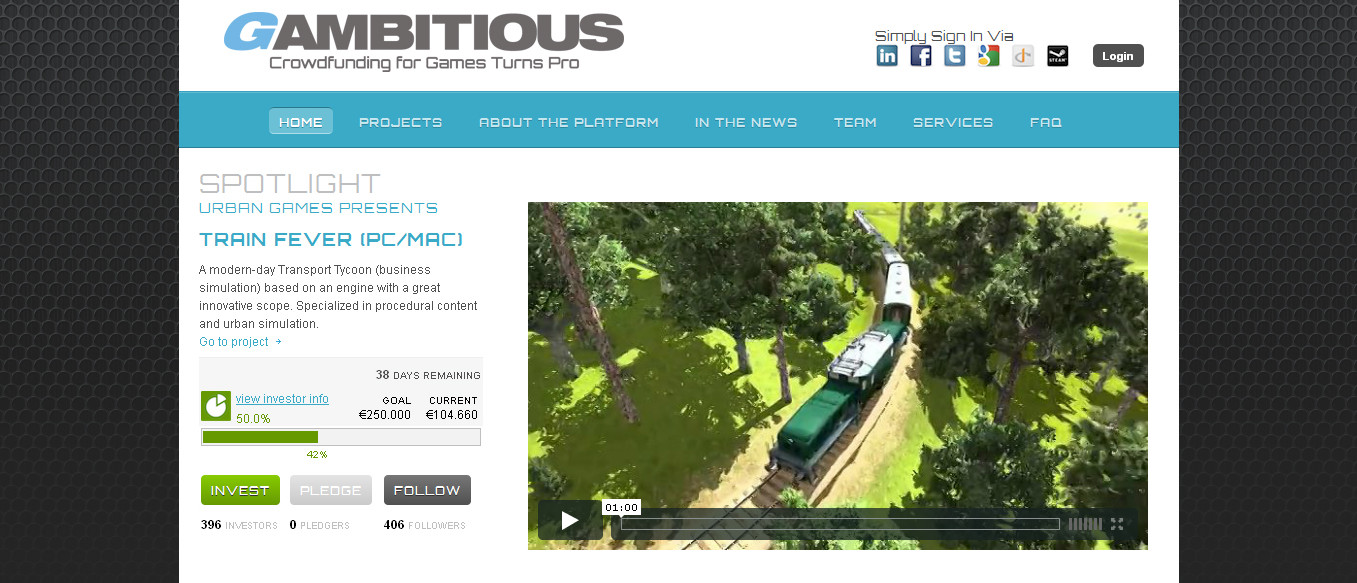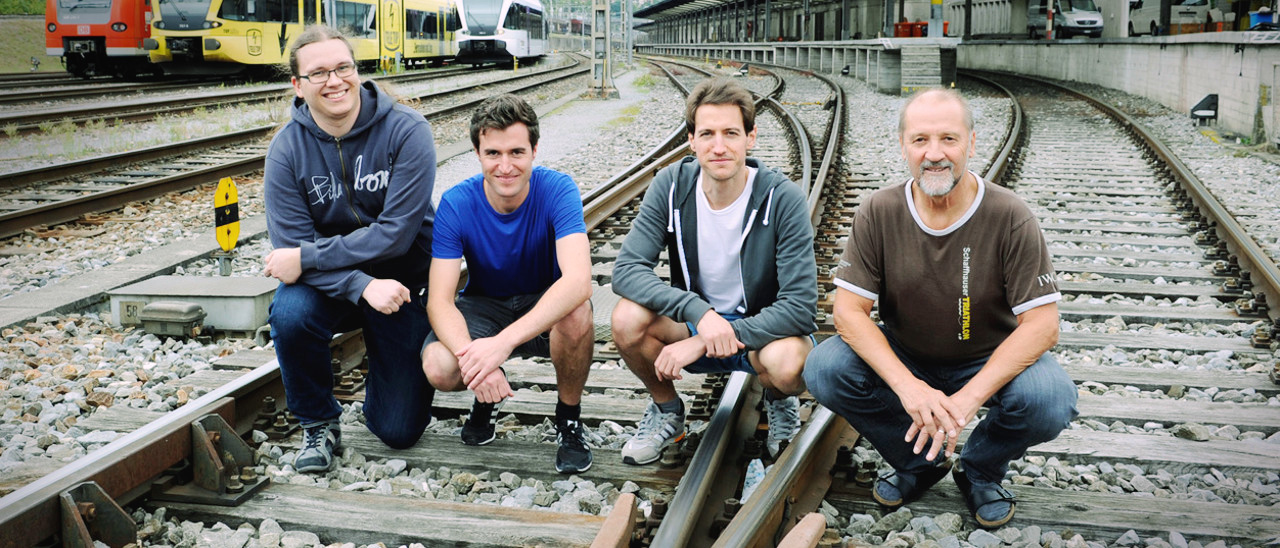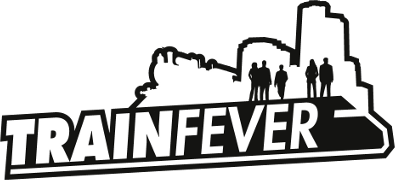Last time we gave you some insight on how we handle feedback. Today we want to share some more delicate details with you: The time right around the release is without any doubt the most stressful and tense part of making a game but at the same time the most thrilling and rewarding. We would like to tell you what we experienced and what knowledge we gained.
After Train Fever reached the prototype state in 2012, a successful crowdfunding campaign took place between September 2012 and March 2013 which enabled us to plan for finishing the development. After the campaign reached its goal of 250.000 Euros on March 20, 2013, the release was scheduled for May 2014.
 The successful crowdfunding campaign on Gambitious funded the game’s development.
The successful crowdfunding campaign on Gambitious funded the game’s development.
As (almost) usual in game development, it became clear that a lot of features will take longer to implement than expected. The planned feature list had grown and – opposite to the original idea – now included industrial goods, bigger maps and far more vehicles. The release date had to be pushed back a couple of months to September 2014. The two publishers paid 20.000 Euros each as an advance to cover the costs for the additional development time.
After the majority of the features found their way into the game, the beta test was finally scheduled for July 2014 with less than two months left until the release. Having only so little time for beta testing was not the only thing showing that we really ran out of time. For instance preparing the 64-bit version was probably on the tightest schedule: Testing only started five days prior to the release, luckily we got everything done in time.
But not everything was done prior to release. Although it was planned to be delayed, the Mac version was released one week after the game came out on Steam. In general a lot of polishing had to be shifted past the release and many things had to be left as they were.
Next to all the last minute tasks we also needed to take care of public relations. Even we did not prioritize it, preparing the homepage, make a trailer for the game, sending out steam keys and giving interviews to press consumed a lot of time.
In the end we were forced to publish an unpolished product. Many people asked why the release was not pushed back further to leave more time for development and bug fixes. The answer is quite simple: We had a limited budget from the crowdfunding campaign. After already rescheduling once to September it would have been just too expensive to extend the development again.
Despite all obstacles we still successfully released the game to the public. However, scheduling the release time turned out to be another challenge. Steam releases are usually within the offices hours of Valves´ headquarters between 9am and 5pm PDT (pacific time), which translates to 6pm and 2am CET (central European time). This is why for Europeans most games are unlocked on Steam sometime in the evening.
This was not an ideal situation: In addition to Steam (and later some other platforms), Train Fever is also sold as a retail version containing a Steam key. With stores opening in the morning, people buying the game on the release day might want to play it right away, so unlocking the game in the evening was not an option. Unlocking the game before stores open right after midnight would have been too early, as the potential buyers from Europe – our main target group – could miss the game on Steam. A possible hype generated by a new release could get lost during the night.
Fortunately we were able to persuade a Valve employee to stay in the office until past midnight. After having some coffees, he unlocked the game at 10am CET.
 The Train Fever trailer running on all the TVs in an electronics store after release day.
The Train Fever trailer running on all the TVs in an electronics store after release day.
Releasing digitally and retail at the same time is difficult enough from an organizational standpoint. What furthermore complicated the situation was that there were two publishers involved with different interests. Naturally everybody wanted to change the conditions according to their best interest. The retail publisher wanted to have a lower price than digital, the digital publisher wanted a discount for launch and both were not happy with each other’s decision.
We did our best to mediate and in the end, even there were notable differences in prices and discounts across the various distribution channels and regions, everything went smoothly. Still it took quite some effort to explain the situation to the customers.
Not only was the night before the release short for that certain Valve employee, also here at Urban Games people did not find much sleep. After putting the last touches on the game everybody left the office at around 6am in the morning, only to be back two and half hour later awaiting the release.
~Urban, CTO
In the office it was quite a tense situation. This day would decide if the work of several years was a success or not. Finally, when the sales figures where rising and the first reviews came in – Train Fever scored an unexpected and staggering 82% at GameStar – everybody was relieved. At the end of the day Train Fever even made it into the top seller list on steam.
But the work was far from done. As mentioned in the last blog post, we automatically receive crash logs. With so many people playing the game at the same time our server just could not handle the load and gave up – nobody expected that to happen. With so much going on and everybody already being tired, in that moment it just made us laugh. A reboot later we were ready to receive the crash logs again and started working on the first bug fixes.
Everybody would have needed some time off the days after release, but encouraged by the success we kept on going.
With more and more people buying the game the amount of feedback and support request increased. Also the press showed a lot of interest in the game, asking for interviews. Still being energized from the successful launch we shared too much details about our plans and mentioned what we would like to do in our next game. With a yet unfinished product it was misinterpreted by some players. They assumed we would already be working on the next game, which in fact did not apply for another year.
Not sharing what comes next is just one of the things we learned from making our first game. Developing games is time consuming and costly. A classical beginner’s mistake is scheduling too little time for polishing after all features are implemented. It is better to cut down on features and leave more time to flesh them out.
Making everybody happy – the developers, the publishers and most important the players – is very difficult and with many people involved communication and coordination can get complicated. Deciding on the right price and having every customer treated equally, with digital vs. retail, currency exchange rates and opposing interests involved, is next to impossible.
 The original development team: (ltr) Manu, Basil, Urban, Coach.
The original development team: (ltr) Manu, Basil, Urban, Coach.
It was our first game, so it is to be expected that not everything was done according to the book. But since then over a year has passed and we have put a lot of work into Train Fever fixing bugs, improving the performance and adding new features.
This reflects in very positive feedback from the community and the sales figures of the game: Train Fever sold over 100.000 copies, 10.000 of them from pre-orders, 40.000 only within the first month, and is considered a success.
Overall the joy it brings to release a game outweighs all the stress and exhaustion, but it is still hard work and a lot can be learned from it. Even that some mistakes have to be taken with humor.
We will utilize all the experience we gained in our next game. You are for sure eager to hear about it! We promise to share the first details with you as soon as possible! Until then stay tuned and wait for our next blog post, where we will give you some insight on sales figures and talk about the different distribution channels.

Great info, good for game developer wannabes. I am looking forward to an insight post regarding the actual development featuring coding tips, tools used, technology and maths 🙂 And I hope your next game is Train Fever 2 🙂
Keep up the good work!
Very cool to read these updates! Please, keep doing what you’re doing. 🙂
I for one was very grateful for an early copy to show off on Twitch and YouTube and I have had a successful four series of Train Fever running on my YouTube channel since launch and everyone who watches my video’s has had input to what I do in the game and the feedback I get from everyone is very positive.
This however pales into comparison to the work you have all put in during and after the development for the game and I for one want to thank you for bringing us a truly great game to the market that so many people has had the chance to enjoy and have input in.
Looking forward to your next development, keep up the good work and I wish everyone there all the best for the future.
SlimNasty2013
I wish Train Fever would gain an ability to alter a speed of in-game calendar (time flow) and changing four seasons of a year before the game support is dropped. The current speed of calendar seems equal to such in classic tycoon games. But trains were moving like toys in classic games, the Train Fever is much more realistic: trains have to accelerate, it takes more time, but the calendar is still fast as in ‘toy-ish’ tycoon games. I want to be able to choose a 10 times slower speed of in-game calendar. At least, with the help of a mod. And it would be cool to watch the trees turn yellow, and than turn naked, and snow starts falling, and rising to the sides from the rails in front of fast moving trains… Such a spectacular Train Fever should go to the History of Video Games.
Thanks guys for the candid insight. It’s interesting to hear your side of the equation.
Really looking forward to “Transport Fever” =)
Hard work receives recognition & dedication.
This is really interesting way! Exciting, I can say 😀 Your work is great, really. Keep up!
With a some delay, but russian translate done 🙂
http://transport-games.ru/index.php/page/index.html/_/news/train-fever/za-kulisami-tf-3-reliz-r146